Unlocking Social Potential with Targeted Interventions
In recent years, the importance of social skills development for children with autism spectrum disorder (ASD) has become increasingly apparent. ABA therapy centers play a pivotal role by integrating social skills groups as a core element of their comprehensive programs. These groups provide a structured environment where children can learn, practice, and generalize essential social behaviors that contribute to their overall development, social integration, and independence.
Structured Learning and Observation in Social Skills Groups
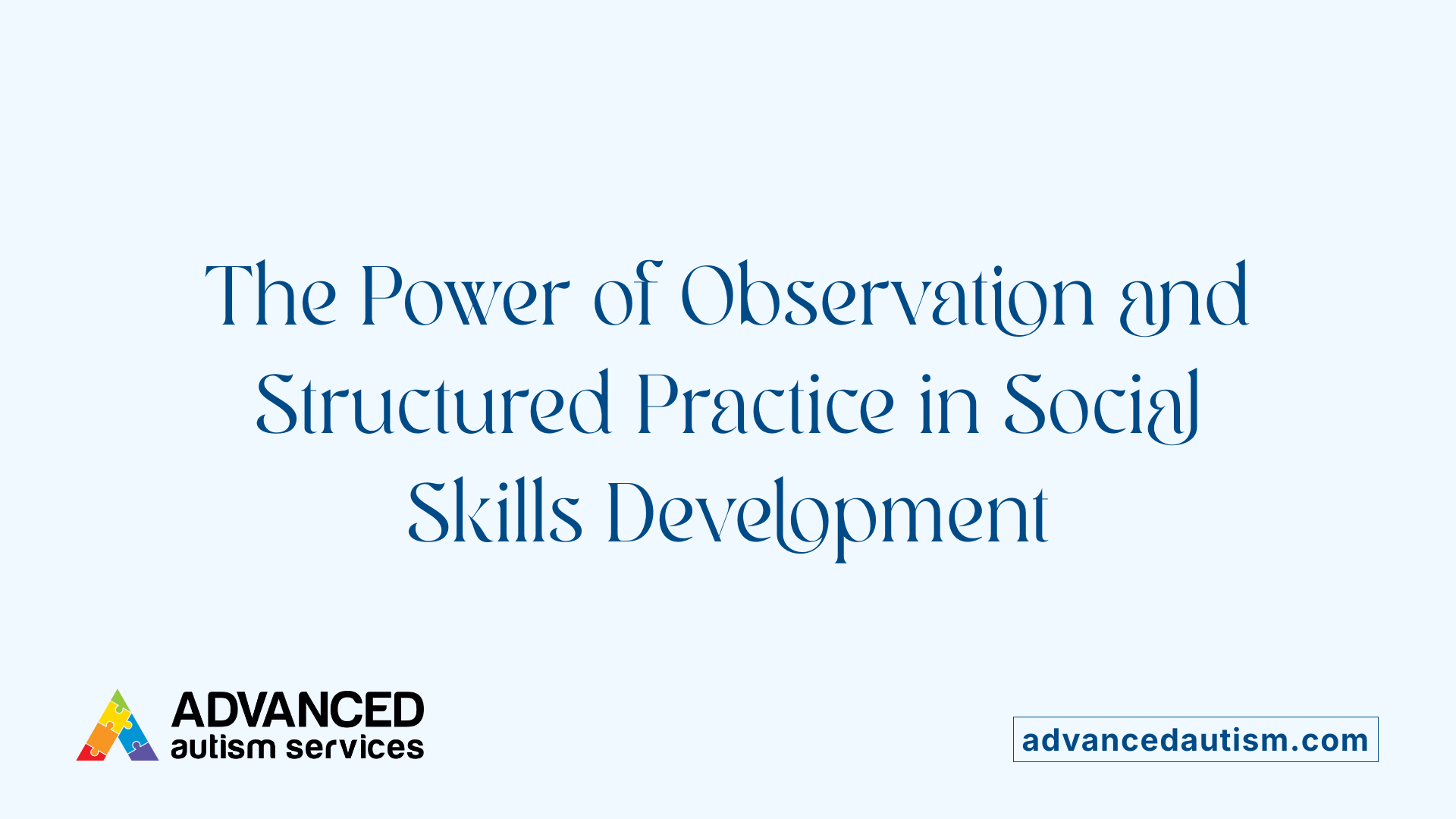
How does modeling and imitation support social development?
Social skills groups serve as a platform where children with autism can observe their peers and facilitators practicing appropriate social behaviors. This observational learning is crucial, as it helps children understand how to act in different social situations. Examples include recognizing nonverbal cues like facial expressions and body language, initiating conversations, and understanding social rules.
Through role-modeling, children see real-life examples of engaging behaviors, which they can imitate. This imitation helps them learn social norms and develop their communication skills naturally. Consistent exposure to these models strengthens their ability to generalize behaviors across settings.
Why is practicing in a controlled environment beneficial?
Structured practice within social skills groups provides a safe and predictable environment for children to develop their social abilities. Activities such as role-playing, social stories, and structured playdates allow children to rehearse social interactions repeatedly. This repetition builds confidence and helps integrate these skills into their daily lives.
In a safe setting, children are more likely to make mistakes without fear of judgment, turning errors into learning opportunities. This approach ensures that children are supported while they refine essential skills such as turn-taking, sharing, and conflict resolution, leading to better social competence and emotional resilience.
| Social Skills Taught through ABA Therapy | Examples | Teaching Methods | Additional Details |
|---|---|---|---|
| Nonverbal communication | Reading facial expressions | Video modeling, role-playing | Helps interpret body language and facial cues |
| Conversational skills | Turn-taking, asking questions | Behavioral rehearsal, visual supports | Encourages engaging in meaningful exchanges |
| Perspective-taking | Understanding others' feelings | Social stories, guided discussions | Develops empathy and social understanding |
| Conflict resolution | Negotiation, calming strategies | Role-playing, positive reinforcement | Builds skills for managing disagreements |
| Problem-solving | Responding to social challenges | Structured tasks, feedback | Promotes independence in handling social issues |
How do social skills groups and ABA therapies work together?
Integrating structured practice with observational learning, ABA therapy employs individualized assessments, evidence-based techniques, and continuous progress monitoring. Parents and caregivers are involved to reinforce skills at home, ensuring consistency across environments.
In addition, innovations like social skills apps, virtual reality, and communication devices enhance learning experiences. School-based ABA services also provide ongoing support through peer modeling and collaborative efforts with teachers, further promoting social growth.
| Benefits | Description | Supporting Strategies | Long-term Impact |
|---|---|---|---|
| Improved communication | Better verbal and nonverbal skills | Video modeling, storytelling | Stronger peer relationships |
| Increased self-esteem | Confidence in social settings | Positive reinforcement | Enhanced emotional resilience |
| Community integration | Active participation in social activities | Parental involvement, structured practice | Greater independence and career readiness |
Overall, social skills groups within ABA therapy frameworks are designed to create a nurturing environment where children learn, practice, and master vital social skills, preparing them for a more engaging and connected life.
Practical Activities for Developing Social Skills
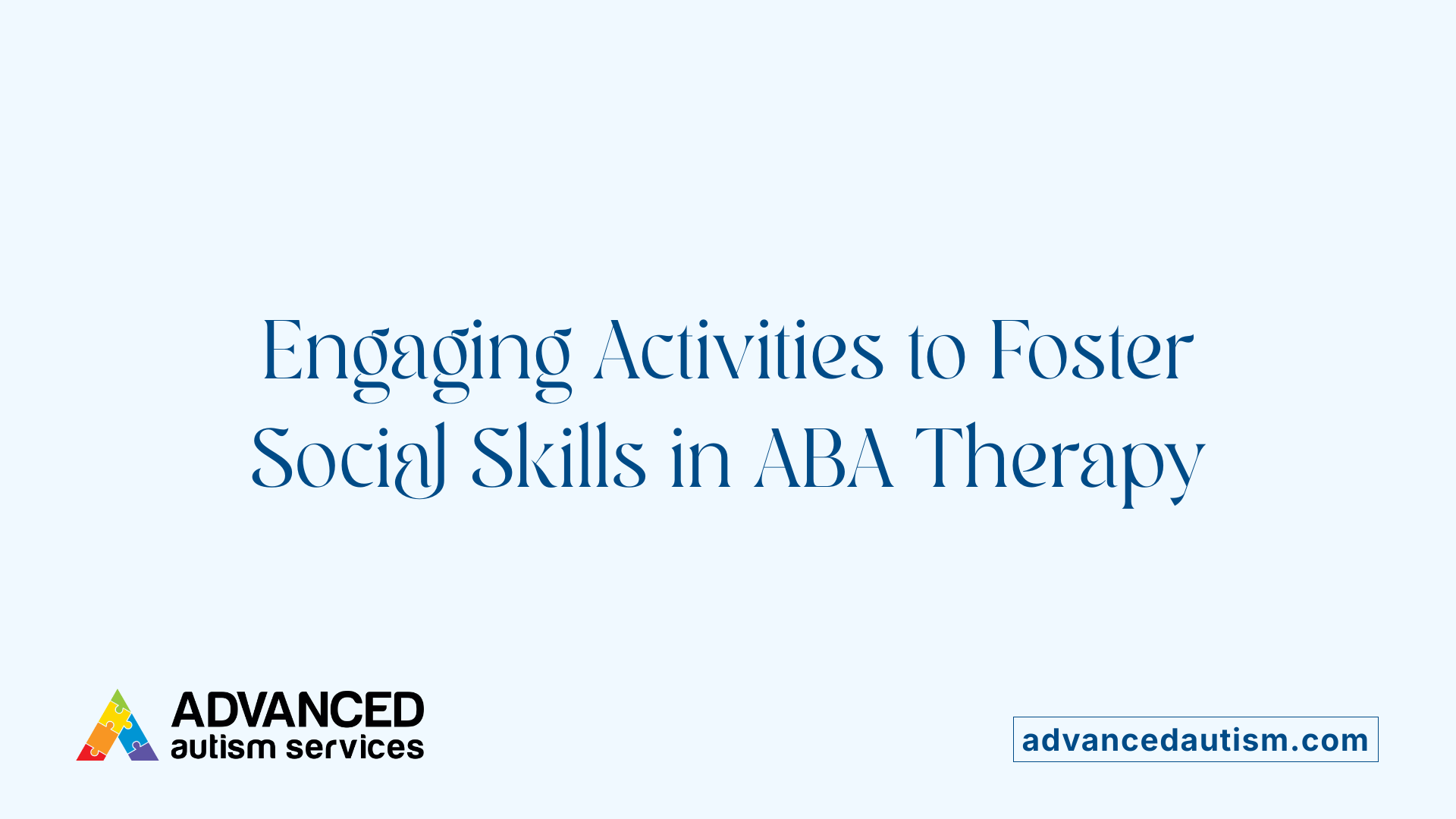
What are common activities used in ABA for teaching social skills?
In ABA therapy, a variety of interactive and engaging activities help children develop their social skills. Popular games like Simon Says, Charades, and 'Would You Rather?' are frequently used to encourage verbal communication, turn-taking, and recognizing emotions. These games serve as fun platforms for children to practice social interactions while learning to interpret body language and facial expressions.
Role-playing exercises are also central to ABA strategies. Activities such as the 'Name Game' or scenarios like 'What Would You Do?' allow children to simulate real-life social situations in a safe, controlled setting. Through these structured activities, children learn how to initiate conversations, navigate social rules, and respond appropriately to peers.
Visual supports like social stories, picture cards, and cue cards complement these activities, providing visual cues to reinforce understanding of social cues and behaviors. Combining role-playing with visual supports ensures multisensory learning, which enhances the acquisition of social skills.
What are the goals of social skills group ABA?
The primary aim of social skills groups in ABA is to help children with autism improve their abilities to interact successfully with others. This involves teaching core behaviors such as initiating conversations, sharing, taking turns, and understanding social cues like facial expressions and tone of voice.
Through targeted activities, children learn to recognize and interpret social signals, which fosters better peer relationships and effective communication. Building these skills helps children understand social norms and develop empathy, making social interactions more rewarding and less stressful.
Additionally, these groups aim to empower children to generalize their new skills across various environments — school, community, and home — by encouraging collaboration among therapists, parents, and teachers. The overall goal is to support long-term social competence that contributes to improved self-esteem, emotional resilience, and overall well-being.
| Activity Type | Description | Purpose/Benefit |
|---|---|---|
| Games (e.g., Charades, 'Would You Rather?') | Interactive games promoting communication and emotion recognition | Enhances verbal skills, social awareness, and turn-taking |
| Role-Playing | Simulated social scenarios for practice | Builds confidence, understanding of social rules |
| Visual Supports | Social stories, picture cues | Reinforces understanding of social cues, reduces anxiety |
| Structured Playdates | Organized peer interactions | Facilitates real-life social practice |
| Video Modeling | Watching videos demonstrating social behaviors | Improves comprehension of non-verbal cues and social responses |
Activities in ABA social skills training are diverse and adaptable, ensuring that children receive relevant, engaging, and effective opportunities to grow socially.
Core Objectives of Social Skills Groups in ABA Settings
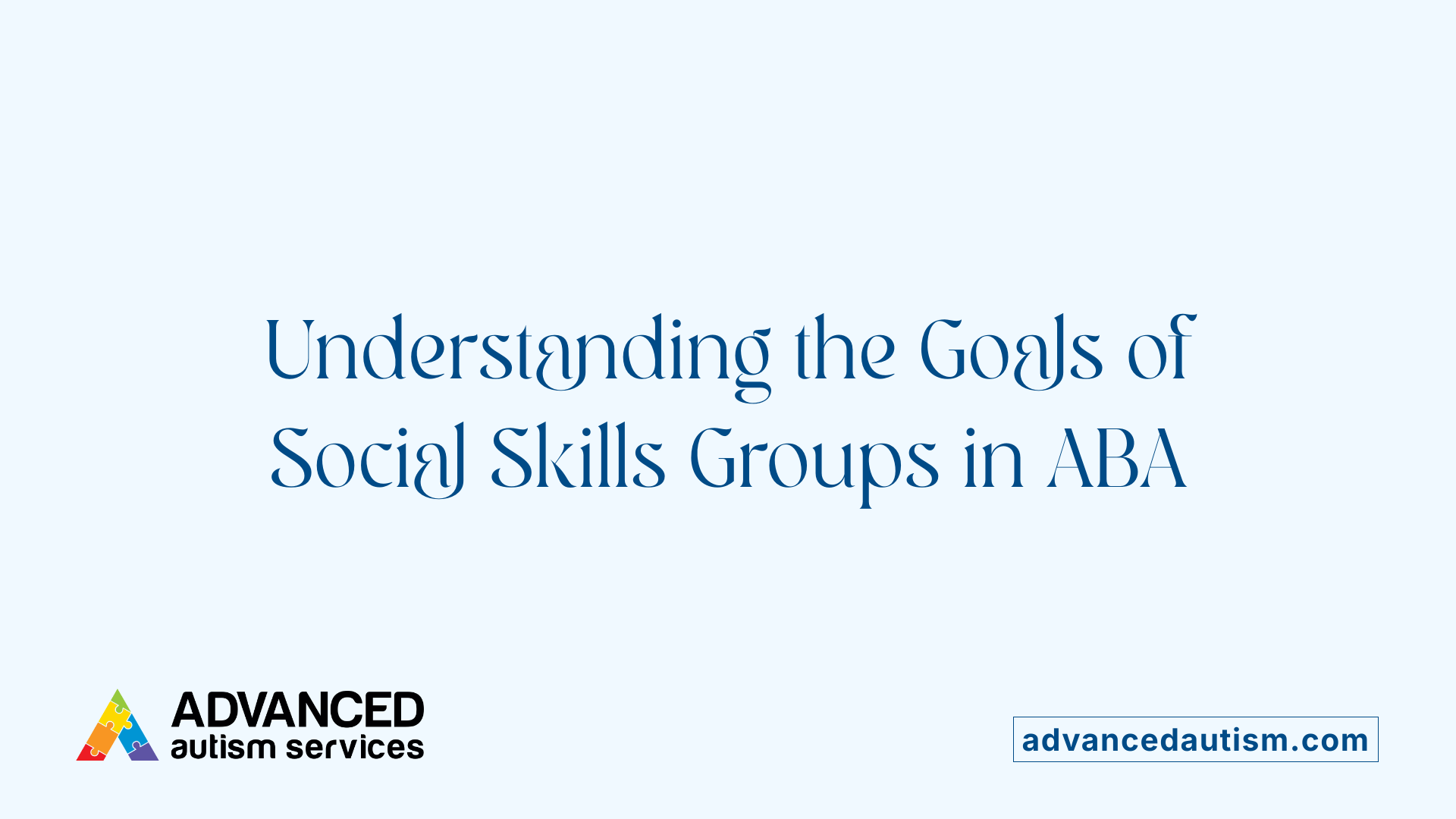
What is the purpose of social skills groups in ABA therapy?
Social skills groups are a vital element within ABA therapy, aimed at teaching children with autism how to interact effectively and appropriately with their peers. These groups typically include small numbers of children, guided by trained adults such as teachers, psychologists, or speech therapists. The structured setting provides a safe environment for kids to observe and imitate positive social behaviors.
The main focus is on developing skills like initiating conversations, understanding social cues, building friendships, resolving conflicts, and regulating emotions. Through activities like role-playing, social stories, and group play, children learn to navigate social situations more comfortably. Video modeling and positive reinforcement are often used to strengthen these behaviors.
What are the goals of social skills group ABA?
The primary goal of social skills groups in ABA is to enhance children's ability to communicate and interact effectively with others. By teaching essential social behaviors—such as understanding nonverbal cues, turn-taking, sharing, and showing empathy—these programs help children improve their social competence.
Furthermore, developing these skills contributes to greater social inclusion, personal growth, and community integration. These groups also aim to promote self-confidence and self-esteem, motivating children to continue practicing and expanding their social abilities.
Overall, the purpose of social skills groups within ABA therapy is to foster meaningful peer interactions and lay a foundation for lifelong social success.
Individualized Approach and Parental Involvement
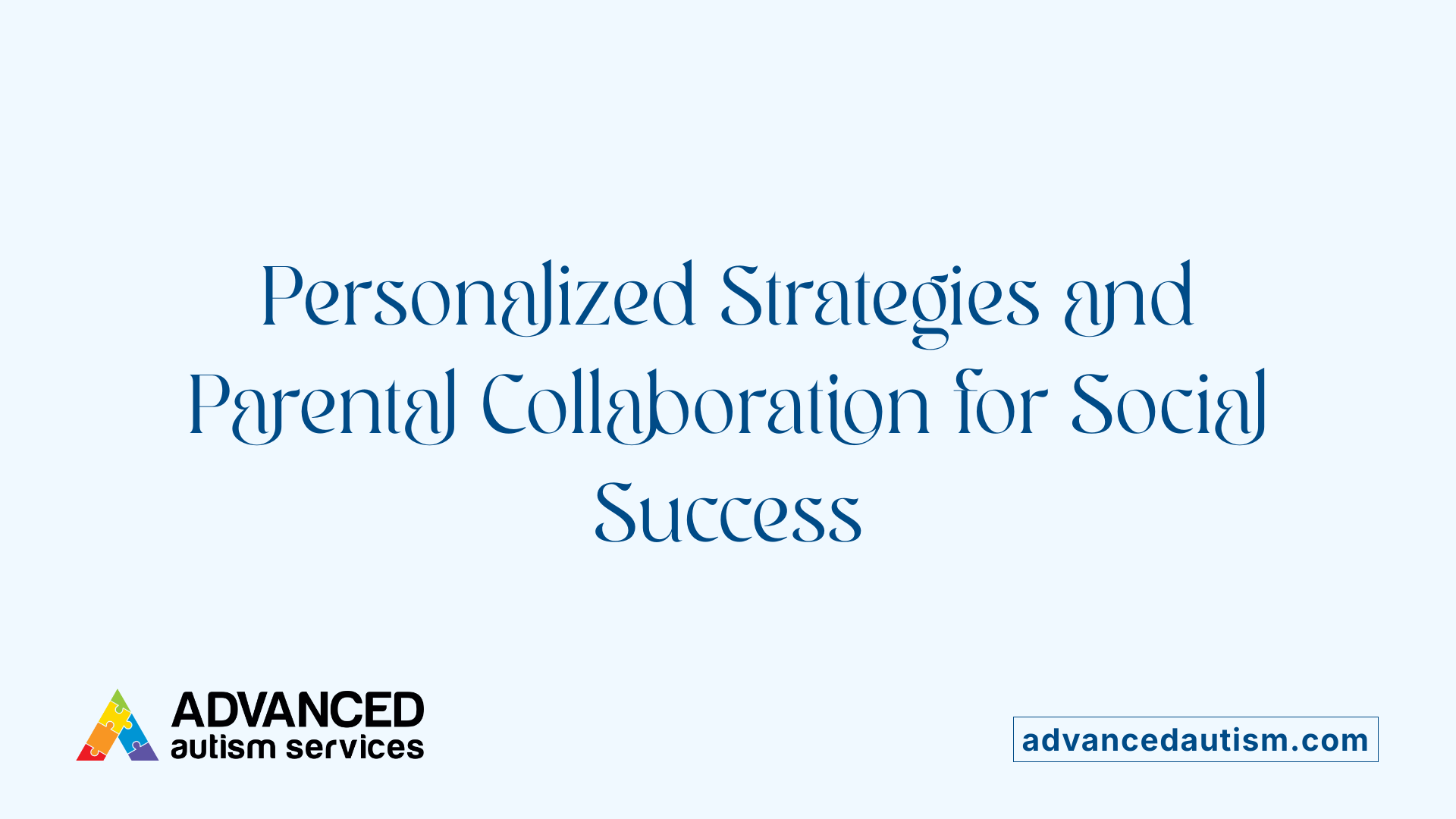
Why are social skills important in ABA therapy?
Social skills are fundamental in ABA therapy because they help children with autism interact effectively with others. These skills promote social integration, independence, and reduce challenges like difficulty initiating conversations or understanding social cues. Developing social competence enhances relationships in family, school, and community settings, supporting overall well-being.
How is social skills training tailored to individual needs?
An individualized approach begins with comprehensive social skills assessments, which help identify each child's strengths and challenges. Based on this, therapists develop personalized plans that focus on core skills such as communication, empathy, sharing, and conflict resolution. Techniques like role-playing, social stories, and positive reinforcement are adapted to suit the child's age and specific needs.
Why is parental involvement emphasized?
Involving parents and caregivers is a vital part of the process. Therapists collaborate with families to ensure consistency across environments. They provide resources, strategies, and home-based activities like peer playtimes and visual supports to reinforce skills learned during therapy sessions. Parental engagement boosts the likelihood of skill generalization and long-term success.
How does collaboration with families enhance social skills development?
By working closely with families, therapists can tailor interventions to real-life situations children encounter daily. This partnership ensures that progress is monitored consistently, adjustments are made as needed, and children receive continuous support outside therapy centers. Ultimately, this collaborative effort fosters a comprehensive environment conducive to social growth.
What are the broader benefits of this personalized approach?
Implementing an individualized, family-centered program helps children develop better social communication, stronger peer relationships, and higher self-esteem. Over time, this can lead to improved academic performance, emotional resilience, and increased community participation—contributing significantly to overall quality of life.
Comprehensive Strategies for Social Skill Acquisition
What is the purpose of social skills groups in ABA therapy?
Social skills groups play a vital role in ABA therapy by providing a controlled environment where children with autism can observe and imitate social behaviors. These groups aim to teach children how to interact effectively with peers, improving skills such as communication, friendship-building, problem-solving, and understanding social cues. Led by trained professionals, the groups include activities like role-playing, social stories, and games that foster social competence.
What are common activities used in ABA for teaching social skills?
Therapists incorporate various engaging activities to make learning social skills effective and fun. Games such as Simon Says, Charades, and 'Would You Rather?' encourage children to practice turn-taking, communication, and emotional recognition. Structured exercises like the 'Name Game' or 'What Would You Do?' help children interpret nonverbal cues and develop perspective-taking abilities.
Use of technology and community integration
Modern ABA programs leverage technology such as video modeling, social skills apps, and virtual reality tools to enhance learning. These tools provide visual supports and interactive scenarios to reinforce social behaviors.
Community integration is also emphasized by organizing real-world practice opportunities like community outings and social playdates. These experiences help children generalize learned skills in natural settings, promoting ongoing social success.
Importance of ongoing progress monitoring
Progress monitoring involves continuous assessment through data collection and regular evaluations. Collaboration with parents, teachers, and caregivers ensures consistency across environments. This ongoing review allows therapists to adjust interventions, ensuring that social skills development remains targeted and effective.
| Strategies | Activities | Key Tools | Additional Notes |
|---|---|---|---|
| Observation & Data Collection | Role-playing, peer interactions | Digital apps, social stories | Ensures tailored support |
| Technology Integration | Video modeling, virtual reality | Social skills apps, VR headsets | Enhances engagement |
| Community-based Practice | Social outings, structured community activities | Peer play, social stories | Promotes generalization |
Long-term learning benefits include improved friendships, academic success, self-confidence, and emotional resilience. By combining structured groups, technology, and consistent monitoring, children with autism can develop vital social skills that support their overall growth and community participation.
Long-term Benefits and Community Integration
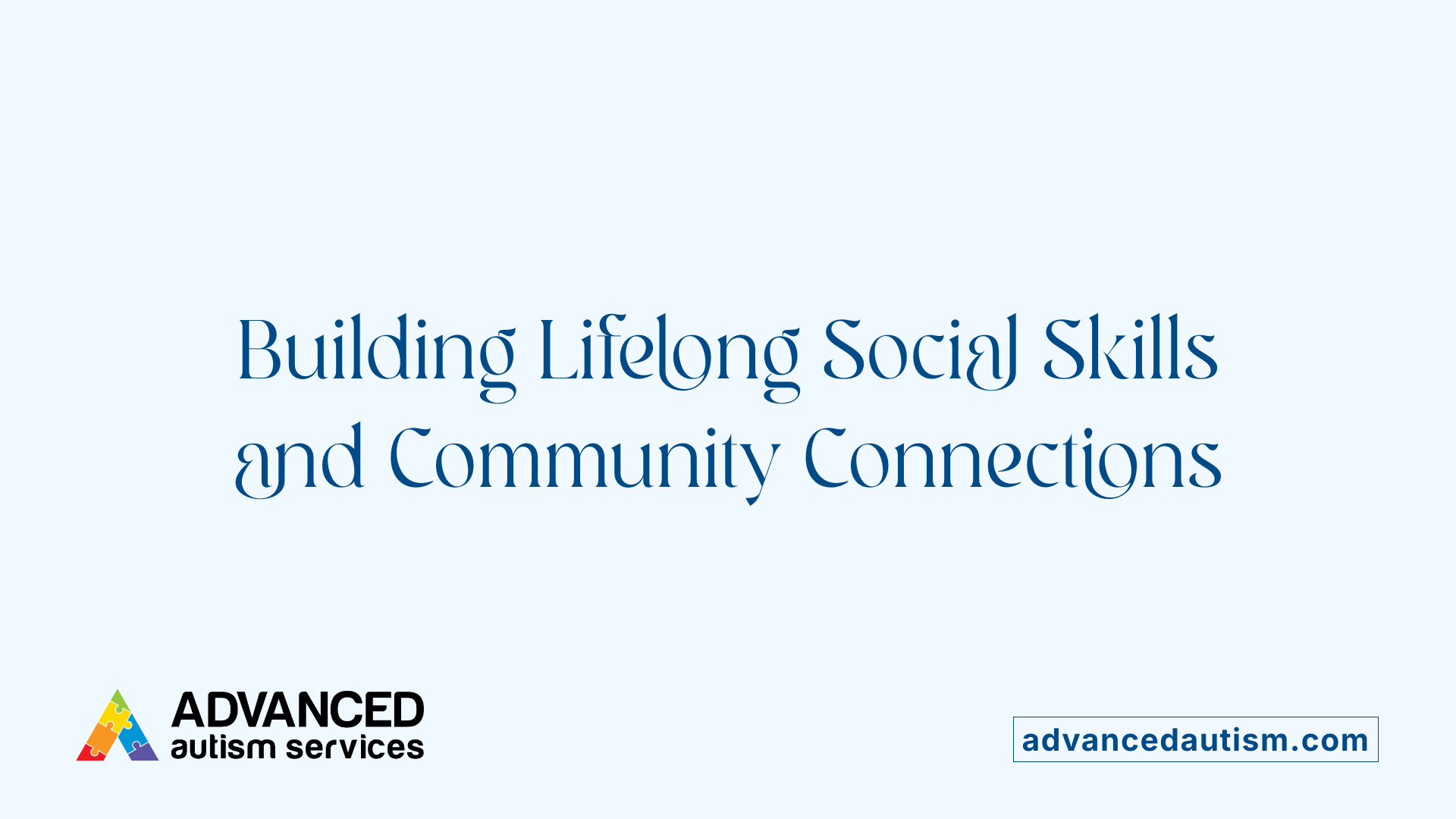 Social skills are fundamental in ABA therapy because they allow children with autism to interact effectively and appropriately within their environment. These skills are crucial for integrating into community and social settings, promoting independence and reducing social challenges. As children develop these skills, they are better able to navigate social interactions across school, home, and community.
Social skills are fundamental in ABA therapy because they allow children with autism to interact effectively and appropriately within their environment. These skills are crucial for integrating into community and social settings, promoting independence and reducing social challenges. As children develop these skills, they are better able to navigate social interactions across school, home, and community.
Engaging in social skills training yields many long-term benefits. Children often form deeper friendships, perform better academically, and demonstrate increased emotional resilience. Building these skills also prepares them for future careers by fostering communication, teamwork, and conflict resolution abilities. Additionally, higher self-esteem and confidence develop as children succeed in social settings.
Participating in social programs within ABA therapy is especially important because they offer a structured environment for learning and practicing social behaviors. These programs help children understand social cues, initiate conversations, and engage with peers meaningfully. With ongoing support from therapists and family, children can generalize learned skills across various contexts, leading to lifelong personal and social growth.
Fostering Lifelong Social Skills for Success
The integration of social skills groups within ABA therapy centers offers a comprehensive approach to developing crucial social competencies in children with autism. These groups not only facilitate the acquisition of fundamental social behaviors through modeled learning, structured practice, and peer interaction but also promote confidence, independence, and community participation. With personalized assessments, evidence-based strategies, and active involvement of families, these programs ensure that skills are effectively learned, generalized, and maintained across various settings. Long-term, these efforts translate into better social integration, emotional resilience, and future readiness, empowering children with autism to flourish socially and academically throughout their lives.
References
- The Role of Social Skills Groups in ABA Therapy for Children
- Developing Social Skills Through ABA Therapy for Autism
- ABA Therapy and Social Skills Program in El Paso, TX
- Social Skills: Helping Children Build Meaningful Connections
- How to Teach Social Skills Using ABA Principles
- ABA Therapy Goals: 25 Practical Examples & Timelines
- ABA 101: Skill Acquisition Plans
- Social Skills Training: Definition, Uses, and Tips - Verywell Mind



